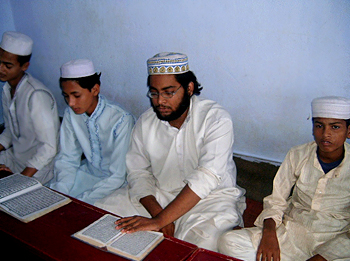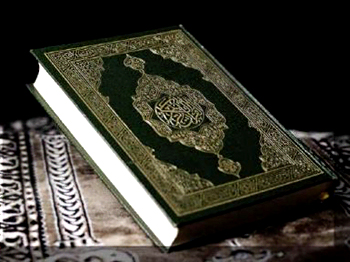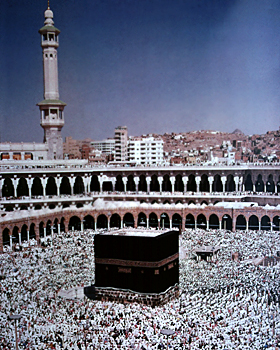 The earliest education in Islam was imparted in the mosques. They served as the earliest schools providing education, and not only did they teach religious subjects but also secular topics such as poetry and literature. About the year 800 a `house of wisdom` was built in Baghdad with a library, staff to look after it, and arrangements for students. An observatory was connected with it. Two hundred years later a similar institution was erected in Cairo, largely for Shia propaganda. Private persons founded similar libraries. Early in the tenth century a man established a school and library with dwellings and allowances in money for the students. Salaried teachers are also mentioned. Some lectured on law in their own houses. About the same time schools (Madrasa) began to be founded, often for a famous teacher. After 1000, such schools became numerous, the best known being the Nizamiya in Baghdad which was dedicated in 1067. The founder is said to have established a school in every town in Iraq and Khurasan. To begin with, the Nizamiya had only one teacher but others were soon appointed. Law was the main subject. A small school might be Hanafi or Shafi while a big school would have teachers for each of the four schools of law. Other religious subjects were often added to the curriculum. A school of grammar is heard of. The mosque still maintained itself as a place of teaching. A man might lecture in a school on law and in a mosque on the Holy Quran. Some schools even included a hospital. The distinction between Mosque and Madrasa was often slight, especially when the Madrasa contained the grave of its founder. There was always a place for prayer which, in later times, often had a pulpit for the Friday prayers. The foundation of Sultan Hasan in Cairo was both Mosque and Madrasa.
The earliest education in Islam was imparted in the mosques. They served as the earliest schools providing education, and not only did they teach religious subjects but also secular topics such as poetry and literature. About the year 800 a `house of wisdom` was built in Baghdad with a library, staff to look after it, and arrangements for students. An observatory was connected with it. Two hundred years later a similar institution was erected in Cairo, largely for Shia propaganda. Private persons founded similar libraries. Early in the tenth century a man established a school and library with dwellings and allowances in money for the students. Salaried teachers are also mentioned. Some lectured on law in their own houses. About the same time schools (Madrasa) began to be founded, often for a famous teacher. After 1000, such schools became numerous, the best known being the Nizamiya in Baghdad which was dedicated in 1067. The founder is said to have established a school in every town in Iraq and Khurasan. To begin with, the Nizamiya had only one teacher but others were soon appointed. Law was the main subject. A small school might be Hanafi or Shafi while a big school would have teachers for each of the four schools of law. Other religious subjects were often added to the curriculum. A school of grammar is heard of. The mosque still maintained itself as a place of teaching. A man might lecture in a school on law and in a mosque on the Holy Quran. Some schools even included a hospital. The distinction between Mosque and Madrasa was often slight, especially when the Madrasa contained the grave of its founder. There was always a place for prayer which, in later times, often had a pulpit for the Friday prayers. The foundation of Sultan Hasan in Cairo was both Mosque and Madrasa.
Method of Instruction
 The earlier method of instruction was dictation. The teacher read a passage from a text and then commented on it, the students writing as he spoke. Sometimes there was an assistant (Mustamli) to read the text or this task might be given to a student. Great freedom in asking questions was allowed. There might be other assistants who went over the day`s work with the less gifted students. Later on the practice of dictation lapsed and the teacher lectured freely. After studying a text with his teacher a student received a licence (Ijaza) to teach it. When such a licence went back by a series of teachers to the author of the book it was highly prized. There was also a general licence to teach all the works of the master. The boundary between teacher and student was not sharply drawn. A man might be teacher in one subject and student in another. The teachers were organised in some way. About 800 a man in Egypt held the chieftainship of the teachers which presumes some organization even in those early times though the details are not known.
The earlier method of instruction was dictation. The teacher read a passage from a text and then commented on it, the students writing as he spoke. Sometimes there was an assistant (Mustamli) to read the text or this task might be given to a student. Great freedom in asking questions was allowed. There might be other assistants who went over the day`s work with the less gifted students. Later on the practice of dictation lapsed and the teacher lectured freely. After studying a text with his teacher a student received a licence (Ijaza) to teach it. When such a licence went back by a series of teachers to the author of the book it was highly prized. There was also a general licence to teach all the works of the master. The boundary between teacher and student was not sharply drawn. A man might be teacher in one subject and student in another. The teachers were organised in some way. About 800 a man in Egypt held the chieftainship of the teachers which presumes some organization even in those early times though the details are not known.
Payment of Teacher
A strong feeling existed that a teacher, especially of religion, ought not to take pay for his services. Most saw no harm in paying a teacher though some said that he ought not to fix his fee but take what was offered. Later, however, it was usual for teachers to be paid from the endowments of the institution. Still later the emoluments of both teachers and students were estimated in loaves of bread. Some earned their living by trade or profession, such as a weaver, a bookbinder and an engraver of gems.
Subjects of Education
The subjects studied were classified in two ways- those connected with religion and those not so connected.
Subjects Connected with religion
 They are those concerned with the Holy Quran, the recitation of the sacred book (Tajwid), the readings, and interpretation, then tradition with the relevant facts about the reporters (Him al rijal) and the abrogating and abrogated verses, law and the principles of law, dogmatic theology and religious observances. As Arabic is the language of the Quran, all studies that aided the understanding of the book come under this head. They are grammar, rhetoric, lexicography, literature and prosody. Further, mathematics and astronomy are needed to calculate the direction of Mecca (Qibla) and for the division of inheritances.
They are those concerned with the Holy Quran, the recitation of the sacred book (Tajwid), the readings, and interpretation, then tradition with the relevant facts about the reporters (Him al rijal) and the abrogating and abrogated verses, law and the principles of law, dogmatic theology and religious observances. As Arabic is the language of the Quran, all studies that aided the understanding of the book come under this head. They are grammar, rhetoric, lexicography, literature and prosody. Further, mathematics and astronomy are needed to calculate the direction of Mecca (Qibla) and for the division of inheritances.
Subjects not connected with religion
The studies not connected with religion are called ancient studies, natural, philosophical, foreign or `Aqli` (founded on reason). They are logic, theory of numbers, geometry, astronomy, music-the study of tones and the determination of them by number, natural sciences, i.e. the study of bodies in rest and motion, heavenly bodies, human, vegetable, animal and mineral, including medicine and agriculture, and metaphysics. Philosophy soon disappeared from the mosques. In Spain, philosophy and the science of the stars were taught only in secret because adepts in these subjects were suspected of being free thinkers.
The subjects were also divided into main and auxiliary.
1. The main subjects are theology, ethics, law, principles of law, the Holy Quran and tradition.
2. The auxiliary are grammar, rhetoric, prosody, logic, methodology, mathematics and the terminology of tradition. It seems that even medicine was taught in the mosque. The procedure would have been like that of any other subject for religious respect for the human body prevented experiment and the development of anatomy. Even today when a post-mortem has been performed, all parts of the body must be buried together in readiness for the resurrection.
Respect for the teacher was great. The boy`s father was responsible for his body coming into being but the teacher was responsible for his mind. It was better to go wrong after a teacher than to go right without one. Many held that education was not for women, that an educated woman was a danger to her husband. That this view was not universal is shown by the biographical dictionaries of the thirteenth to the fifteenth centuries where hundreds of women scholars are named, particularly as students and teachers of tradition.
Thus Islamic education evolved in a systematic manner down the ages. The one factor that has remained central in Islamic education despite the innovations in the method and curriculum of study, has been the importance given to religious doctrine. It forms the central aspect of the Muslim educational system.









